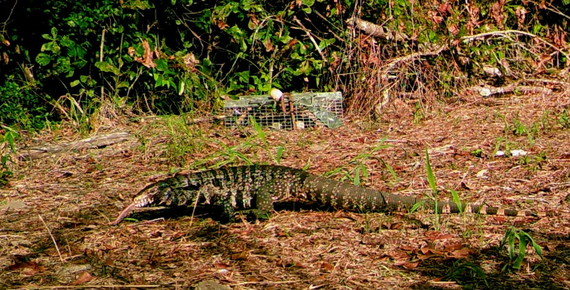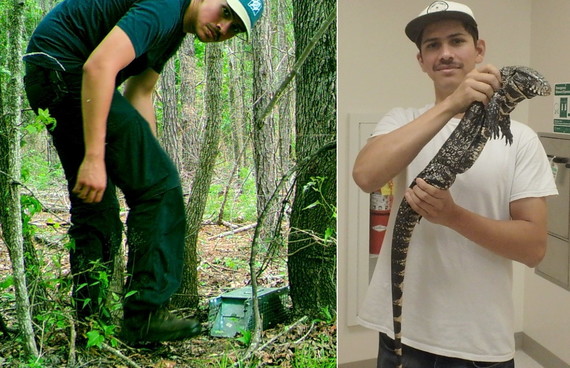 Argentine black and white tegu (Dustin Smith)
Be on the Lookout for Tegus
Going hunting this month in Toombs or Tattnall County?
Keep an eye out for tegus and let Georgia DNR know if you spot one of the big South American lizards.
DNR is working with the U.S. Geological Survey and Georgia Southern University to remove a wild population of Argentine black and white tegus in Toombs and Tattnall. Likely started by escaped or released pets, these tegus pose a significant threat to native wildlife.
“Our hunters can be a valuable resource in controlling the tegu population,” said Wildlife Resources Division Director Rusty Garrison. “If you are a hunter in this area of the state, please be on the lookout and let us know whether the tegu is dead or alive.”
In Georgia, tegus can be trapped or killed in a humane fashion and in accordance with local ordinances. As a non-native species, they are not protected by state wildlife laws or regulations.
Argentine black and white tegus, the largest tegu species, will eat the eggs of ground-nesting birds—including quail and turkeys—and other reptiles, such as alligators and gopher tortoises. They will also eat chicken eggs, fruit, vegetable crops, plants, pet food and small live animals, from grasshoppers to gopher tortoise hatchlings. There are concerns, as well, that tegus could cause bacterial contamination of crops and transmit internal parasites to native wildlife.
 This large tegu was caught in late August in western Tattnall County. (USGS)
DNR and partners are trapping tegus and tracking sightings. But your help is needed.
In late summer and fall, tegus will be more active before they retreat into burrows for brumation, or reptile hibernation, which will begin as early as October.
Argentine black and white tegus are primarily active by day. Hatchlings (which have green heads until about 1 month old) are at least 6-8 inches long. But they grow fast. Adults captured in Georgia have been about 3 feet or longer. In comparison, none of Georgia's native lizards with legs reaches more than a foot long.
Six tegus have been collected in Tattnall and Toombs counties this year.
If you see, trap or kill a tegu, take a photo (if possible) and report the animal and the location by clicking the button above.
Questions? Contact (478) 994-1438 or gainvasives@dnr.ga.gov.
As with any wild animal, use appropriate caution. While tegus in the wild do not pose a specific threat to people or pets, they have strong jaws and sharp teeth, and can bite and scratch and even lash with their tails.
Learn more at georgiawildlife.com/tegus, including how to identify tegus from native reptiles.
 USGS student contractor Danny Haro shows a trap and a captured tegu (left/USGS; right/Georgia Southern)
Stay in Touch
Our emails will keep you up-to-date about important news. We promise we won't overwhelm you with emails; but if you wish, you can unsubscribe here.
Connect with us
Questions? Give us a call at 1-800-366-2661
Visit us at georgiawildlife.com
Headquarters address:
2067 U.S. Highway 278 SE
Social Circle, GA 30025
|